Extra chmod command options Verbose Changes Silent Default Recursive PreserveRoot Reference File Setuid Setgid Sticky Bit Use the octal CHMOD Command chmod R 700 folder_name OR use the symbolic CHMOD Command chmod R arwx,grwx,orwx folder_name Chmod Permissions for chmod 700 Chmod owner Owner can read;In Unix and Unixlike operating systems, chmod is the command and system call which is used to change the access permissions of file system objects It is also used to change special mode flags The request is filtered by the umask The name is an abbreviation of change mode Modes are the filesystem permissions given to "user", "group" and "others" classes to access files under Unix They are shown when listing files in long format, or, if accesscontrol lists are in use, using getfacl Modes cLinux chmod Command The chmod ( ch ange mod e) command in Linux is used to change the access mode of a file, based on the type of user accessing the file and the type of permission associated with accessing the file

How To Run Unix Shell Command In Java Like Chmod Mkdir Grep Or Any Unix Commands Javaprogramto Com
Chmod linux command example
Chmod linux command example-The chmod command A normal consequence of applying strict file permissions, and sometimes aExtra chmod command options Verbose Changes Silent Default Recursive PreserveRoot Reference File Setuid Setgid Sticky Bit Use the octal CHMOD Command chmod R 644 folder_name OR use the symbolic CHMOD Command chmod R arwx,ux,gwx,owx folder_name Chmod Permissions for chmod 644 Chmod owner Owner can read;



Linux Chmod Recursive How To Change File Permissions Recursively
The find command searches for files or directories under /var/www/html and passes each found file or directory to the chmod command to set the permissions When using find with exec, the chmod command is run for each found entry Use the xargs command to speed up the operation by passing multiple entries at onceChmod (change mode) is one of the most frequently used commands in unix or linux operating system The chmod command is used to change the file or directory access permissions To know about the access permissions of a file or directory, use the ls l command as shown below $ ls l samplesh rwxrwr 1 matt deploy 94 Oct 4 0312 sampleshChmod is a great Linux command for manipulating file and directory permissions With the concepts mentioned in this article, you are equipped with sufficient knowledge to handle permissions in Linuxbased distros
Use the octal CHMOD Command chmod R 644 folder_name OR use the symbolic CHMOD Command chmod R arwx,ux,gwx,owx folder_nameIn Linux Quick Fix;How to Use the chmod Command in Linux Command Syntax Below is a list of numerical permissions that can be set for the user, group, and everyone else on the Command Examples The first 7 sets the permissions for the user, the second 7 sets the permissions for the group, and More Information on
About chmod command The chmod command is used to define or change permissioins or modes on files and limit access to only those who are allowed access It changes the mode of each FILE to MODE The chmod command stands for change mode and it's used to limit access to resources It's a same as using your mouse to rightclick a file or folder and selecting the permission tabs andThe chmod (ch ange mod e) command in Linux is used to change the access mode of a file, based on the type of user accessing the file and the type of permission associated with accessing the fileChmod stands for change mode, which changes the file or directory mode bits To put it simply, use chmod command to change the file or directory permissions Following is a sample of ls l command output In this, the 9 characters from 2nd to 10th position represents the permissions for the 3 types of users



Part 12 Unix Linux For Testers Chmod Command File Access Permissions Youtube



Linux Chmod Recursive How To Change File Permissions Recursively
Chmod 644 ~/ssh/id_rsapub (ie chmod a=r,uw ~/ssh/id_rsapub) would also be correct, but chmod 644 ~/ssh/id_rsa (ie chmod a=r,uw ~/ssh/id_rsa) would not be Your public key can be public, what matters is that your private key is private Also your ssh directory itself must be writable only by you chmod 700 ~/ssh or chmod u=rwx,goChmod command is useful to change permission for Files and folders in Linux/Unix File/Directory permission is either Read or Write or executable for either user or group or others This type of restriction is useful for effective file/folder management, securing system and providing a level of access to a file/folder for the users who access themHow to Use the chmod Command on Linux chmod Modifies File Permissions In Linux, who can do what to a file or directory is controlled through sets of Viewing and Understanding File Permissions We can use the l (long format) option to have ls list the file permissions Understanding The



Cannot Find Chmod Metasploit Installation Stack Overflow


Configure Powershell Remoting Between Windows And Linux Lightnetics
Description On Unixlike operating systems, a set of flags associated with each file determines whoChmod command in Linux with examples Difficulty Level Medium Last Updated 19 Feb, 21 In Unixlike operating systems, the chmod command is used to change the access mode of a file The name is an abbreviation of change modeChmod 644 ~/ssh/id_rsapub (ie chmod a=r,uw ~/ssh/id_rsapub) would also be correct, but chmod 644 ~/ssh/id_rsa (ie chmod a=r,uw ~/ssh/id_rsa) would not be Your public key can be public, what matters is that your private key is private Also your ssh directory itself must be writable only by you chmod 700 ~/ssh or chmod u=rwx,go



Linux Commands Linuxconfig Org



Unix It S Me Tommy
What Does "chmod x" Command In Linux and Unix?Linux chmod command is one of the most commonly used commands especially by system administrators when assigning modifying file and folder permissions It's usually used when installing and configuring various services and features in a Linux system The command is usually used together with a set of octal notations or alphabetical charactersThe chmod command can modify the read, write, and execute tasks with just a root password on a Linux system In the entire post, we will discuss the differences between the chmod 777, chmod 755, or chmod 600, and more other chmod commands on the Linux system



How To Use Chmod 777 Command In Linux Explained How To Use Chmod Command Hindi Tutorial Youtube



Linux Chmod Command Utility Software Computer File
By Kashif Siddique Categories Linux Commands, Shell Scripts In this tutorial, I am going through the steps to create a bash script and to make the script executable using the chmod command After that, you will be able to run it without using the sh or bash commandsWhat are file permissions and chmod command in Linux Chmod is an easy command in Linux However, it becomes difficult when you use all of its variations This command executes in so many ways Nevertheless, you need to know about file permissions File permissions decide whether a file is readable, writable, or bothChmod Command chmod command means change mode There are three basic modes to files and directories read, write, and execute Additionally, each of these modes can be applied to the user, the group, or others



7 Linux Change Permissions Of Files Directories Using Chmod Commands Youtube
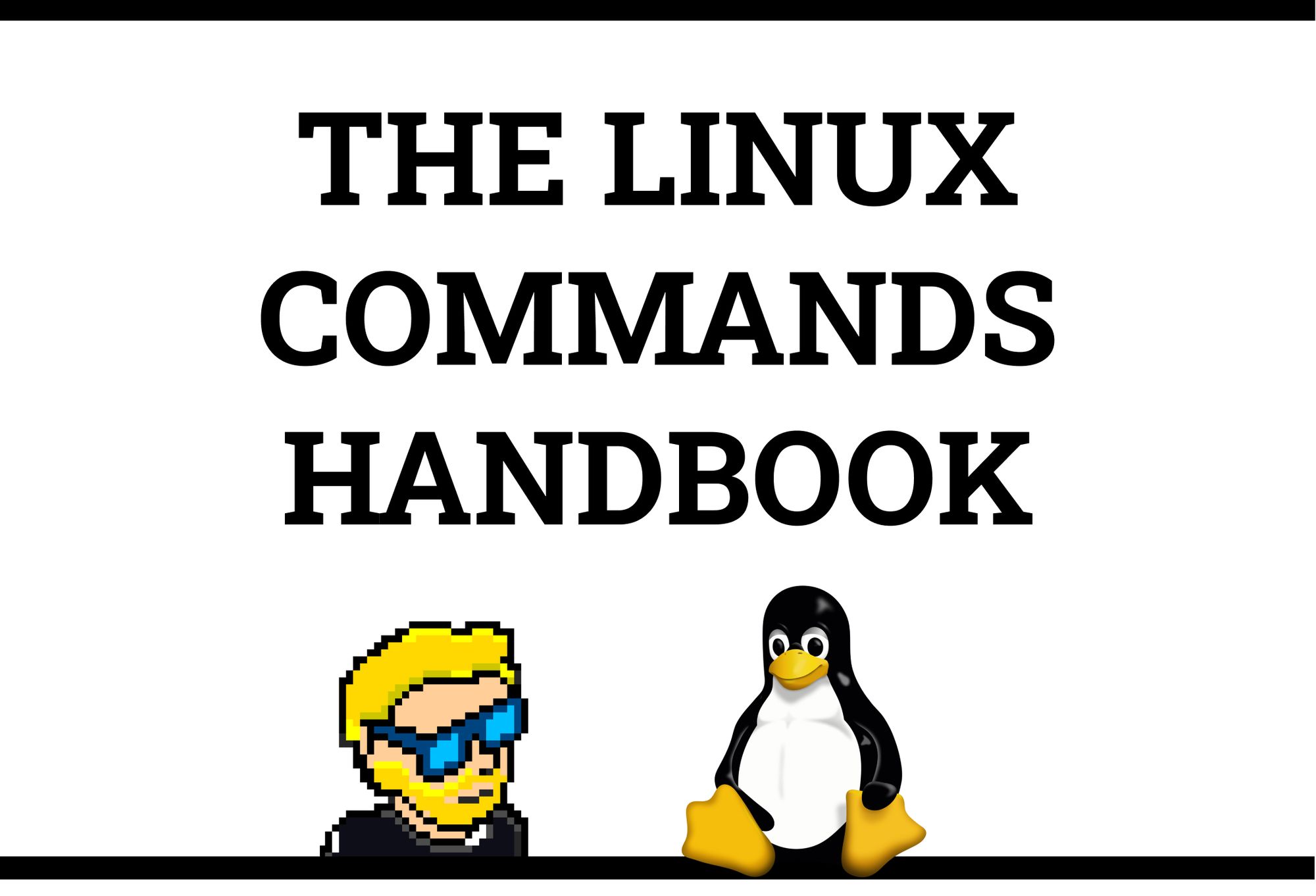


Learn Linux Basics Bash Command Tutorial For Beginners
$ chmod ar sampletxt Make a file readable and writable by the group and others $ chmod gorw sampletxt Make a shell script executable by the user/owner $ chmod ux samplescriptsh Allow everyone to read, write, and execute the file and turn on the set groupID $ chmod =rwx,gs samplescriptsh PrintFor example, to make all sh files in the current directory executable, you would use find name "*sh" exec chmod x {} \;The command syntax for changing the permission of a specific file type in a directory is find directory name "* filename_extension" exec chmod privilege {} \;



Ppt Agenda Powerpoint Presentation Free Download Id


Some Linux Commands Cheat Sheet Linux
The chmod and chown commands are powerful and most popular command line tool that can be used to control access to files in Linuxbased operating systems The chmod also called change mode that is used to change permissions of a given file according to a certain mode The chown command stands for "change owner" is used to change the ownerLinux chmod command is one of the most commonly used commands especially by system administrators when assigning modifying file and folder permissions It's usually used when installing and configuring various services and features in a Linux system The command is usually used together with a set of octal notations or alphabetical charactersThe chmod command allows you to change the permissions of files using symbolic or numeric mode To recursively operate on all files and directories under a given directory, use the chmod command with the R, (recursive) option The general syntax to recursively change the file's permissions is as follows chmod R MODE DIRECTORY



What Are The Top 50 Commands In Linux Quora



D 6 Permission Issues And How To Troubleshoot Engineering Libretexts
The chmod command modifies the permissions of a file or directory on a Linux system The three numbers after the chmod command represent the permissions assigned to user owner, group owner and others The numbers 755 assign readwriteexecute permissions to the user ower and readexecute permissions to group owner and others In this article I will explain the basics of the chmod command and you will learn how to use itIn Linux Quick Fix In this article, we would discuss how to set permissions on files & directories using chmod in Ubuntu distribution chmod is a commandline utility, which is used to change file mode bits But, first we need to discuss a bit about file & directory permissions itself11/02/18 by İsmail Baydan chmod is very useful tool to manage file modes like read write execute One of the most used option for chmod is x which stands for execution rights



Chmod Command In Linux With Examples Geeksforgeeks



How To Change File Permissions In Linux Skillsugar
About chmod command The chmod command is used to define or change permissioins or modes on files and limit access to only those who are allowed access It changes the mode of each FILE to MODE The chmod command stands for change mode and it's used to limit access to resources It's a same as using your mouse to rightclick a file or folder and selecting the permission tabs andOn Unixlike systems, chmod is a systemlevel command that stands for "change mode" and allows you to manually change the permission settings of a file Not to be confused with chown , which is another systemlevel command on Unixlike systems that stands for "change owner" and lets you assign ownership of a file to another user, or chgrp , which stands for "change group" and assigns a file to a different groupChmod Linux Command – chmod ใช้ในการเปลี่ยนสิทธิ์ในการอ่าน, เขียน และ execute file หรือ folder แบ่งเป็นสิทธิ์ของ file owner, group owner, other user ซึ่งคำสั่งจะถูกแปลงจากเลขฐาน 8 ในการระบุ



Linux Commands You Need For The A And Beyond



Linux Commands 5 File Permission Chmod Youtube
Linux chmod Command Change File Permission To Read Write, cmd ExampleThe chmod command A normal consequence of applying strict file permissions, and sometimes a nuisance, is that access rights will need to be changed for all kinds of reasons We use the chmod command to do this, and eventually to chmod has become an almost acceptable English verb, meaning the changing of the access mode of a fileThe Linux command to change permissions on a file or directory is chmod, which we like to read as change file mode chmod has two operating modes symbolic mode;



Chmod How To Set File And Directory Permission In Linux Using Chmod Youtube



Basic Linux Commands Linuxmasterrace
In Linux/Unix like operating system, the chmod command is used to change the access mode of a file It is used to change the permission for files and folders These permissions are given to file/folder to provide a secure environment to the OS, efficient management of a file and highlevel access to the users accessing the files/ foldersThis command is used to view your files with what permission they are To make a file readable andThe chmod command modifies the permission mode of objects in the system It is one of the most used and important commands in the set of Linux security commands A plus () symbol adds a permission, and a minus () symbol removes a permission You can read chmod ur as "user plus read," as it gives the user read permission
/GettyImages-1021092796-ea8c63ee76f84bd5bf98c4222337fbb4.jpg)


How To Use The Chmod Command In Linux



Solved Question 10 Using Linux Terminal Do The Following Chegg Com
The chmod command in Linux/Unix is abbreviated as CH ange MOD e Chmod command is useful to change permission for Files and folders in Linux/Unix File/Directory permission is either Read or Write or executable for either user or group or othersThe chmod command in Linux is used to change file and directory permissions using either text (symbolic) or numeric (octal) notation It takes the following syntax $ chmod OPTIONS MODE filename Only the root user or a regular user with sudo privileges can change file or directory permissionsChmod means 'change mode' and it changes file or directory mode bits (the way a file can be accessed) You can use chmod in the command line to change file or directory permissions on unix or unixlike systems such as linux or BSD



Quiz Worksheet Special Permissions Access Control Filesystem Attributes In Linux Study Com



Chmod 777 A Definitive Guide To File Permissions
In Linux systems, " chmod " command is used to determine the access rights of users to files It allows us to change the access permissions of the files we specify The exact equivalent of chmod is change modeTo change permission using the Linux chmod command we have to follow some syntax and rulesIn Linux/Unix like operating system, the chmod command is used to change the access mode of a file It is used to change the permission for files and folders These permissions are given to file/folder to provide a secure environment to the OS, efficient management of a file and highlevel access to the users accessing the files/ folders



New Bash Linux Cheat Sheet Wallpaper Download Free 40 X 3050px



Linux Permissions Posix Chmod Chown Chgrp Youtube
In this article, we would discuss how to set permissions on files & directories using chmod in Ubuntu distribution chmod is a commandline utility, which is used to change file mode bits But, first we need to discuss a bit about file & directory permissions itselfChmod COMMAND chmod command allows you to alter / Change access rights to files and directories File Permission is given for users,group and others as,



Day 68 Give Read Write And Execute Permission To The File S Owner Read Permissions To The File S In 21 Writing Chmod Command Reading



How Do Linux Permissions Work



Solved Part 2 Linux Shell Scripting Worth 5 Points C Chegg Com



Write Access Chmod Command



Chmod Command In Mac Os X Terminal Youtube



Basic Linux Commands Ubuntu



Ppt Module 15 Ownership And Permissions Powerpoint Presentation Free Download Id



Chmod X Explained Everything You Need To Know



Chmod 755 Command What Does It Do Codefather
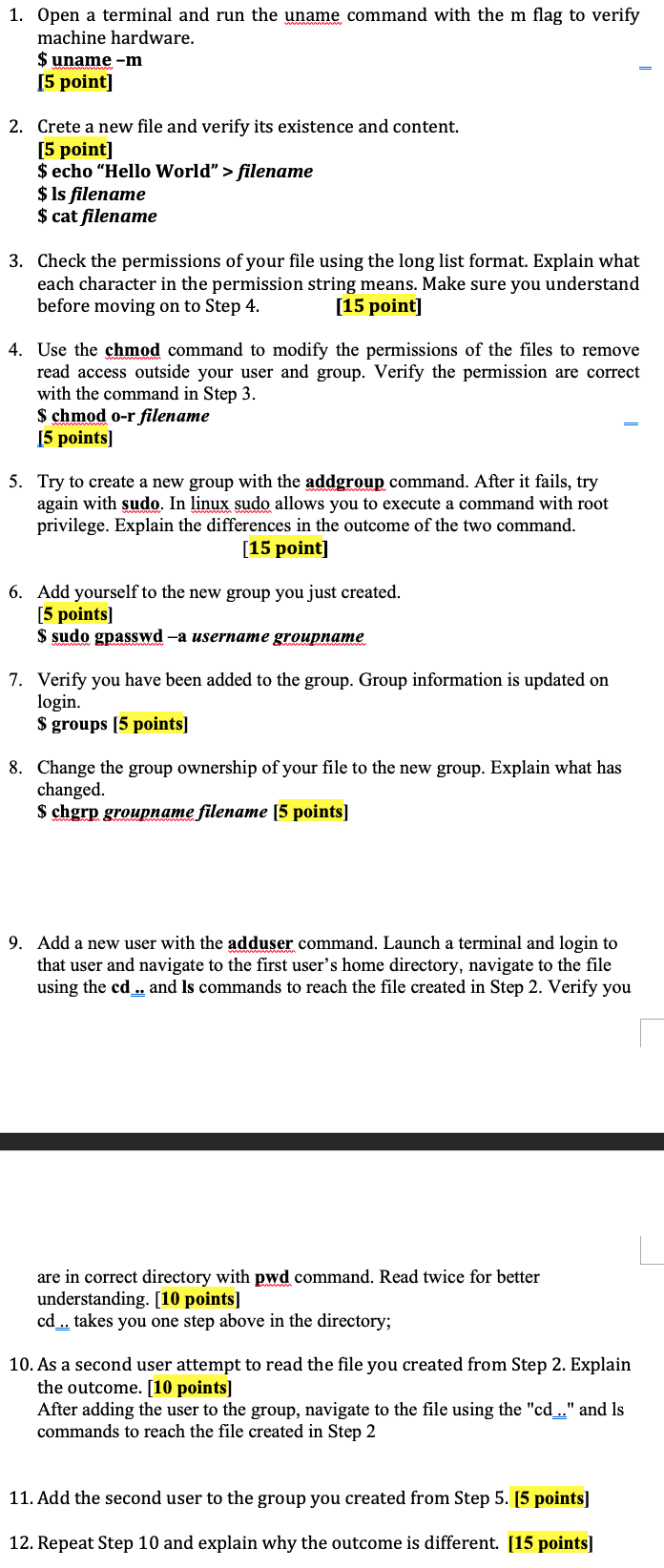


Solved 1 Open A Terminal And Run The Uname Command With Chegg Com
/mkdir-linux-5c4763ffc9e77c00014ae996.png)


How To Create Directories In Linux With The Mkdir Command



How To Use The Chmod Command In Linux Keepthetech



Agenda The Linux File System Chapter 4 In Text Ppt Download



My Knowledge On Chmod When I Was New To Linux Linuxmasterrace



Top 10 Free Best Courses To Learn Linux Command Line In 21 By Javinpaul Javarevisited Medium



What Is Chmod In Windows



Linux Command Line Tutorial 17 Directories And Chmod Youtube



Command Line For Windows An Ok Ssh Program Is Putty Ppt Download



Bash Chmod U X Problem In Case Statement In Shell Script Ask Ubuntu



Kali Linux A Z Commands



How To Use The Chmod Command 2 Minute Linux Tips Network World



How To Use The Chmod Command In Linux The Wise Bulb



Chown Chmod Geek Comic Programmer Jokes Geek Stuff Programming Humor



Change File And Folder Permission On Ubuntu Chmod Chown Command In Linux Youtube



Basics Of Using Chown And Chmod Commands Anto Online



Understand Linux System File Permission



How To Create Write A Simple Sample Linux Shell Bash Script 5 Steps Instructables



Chmod 600


Github Fed Command Line Cheatsheet Unix Command Line Cheatsheet



How To Execute Install Sh Files In Linux Using Terminal 9 Steps



How To Use The Chmod Command In Linux Technotrending



How To Run Unix Shell Command In Java Like Chmod Mkdir Grep Or Any Unix Commands Javaprogramto Com



Linux Command Line Cheat Sheet Kalitut



Permissions And Executables A Primer For Computational Biology
/create-directories-linux-mkdir-command-3991847-55ea75a52f7842a2af0fdfe0b7470270.gif)


How To Create Directories In Linux With The Mkdir Command
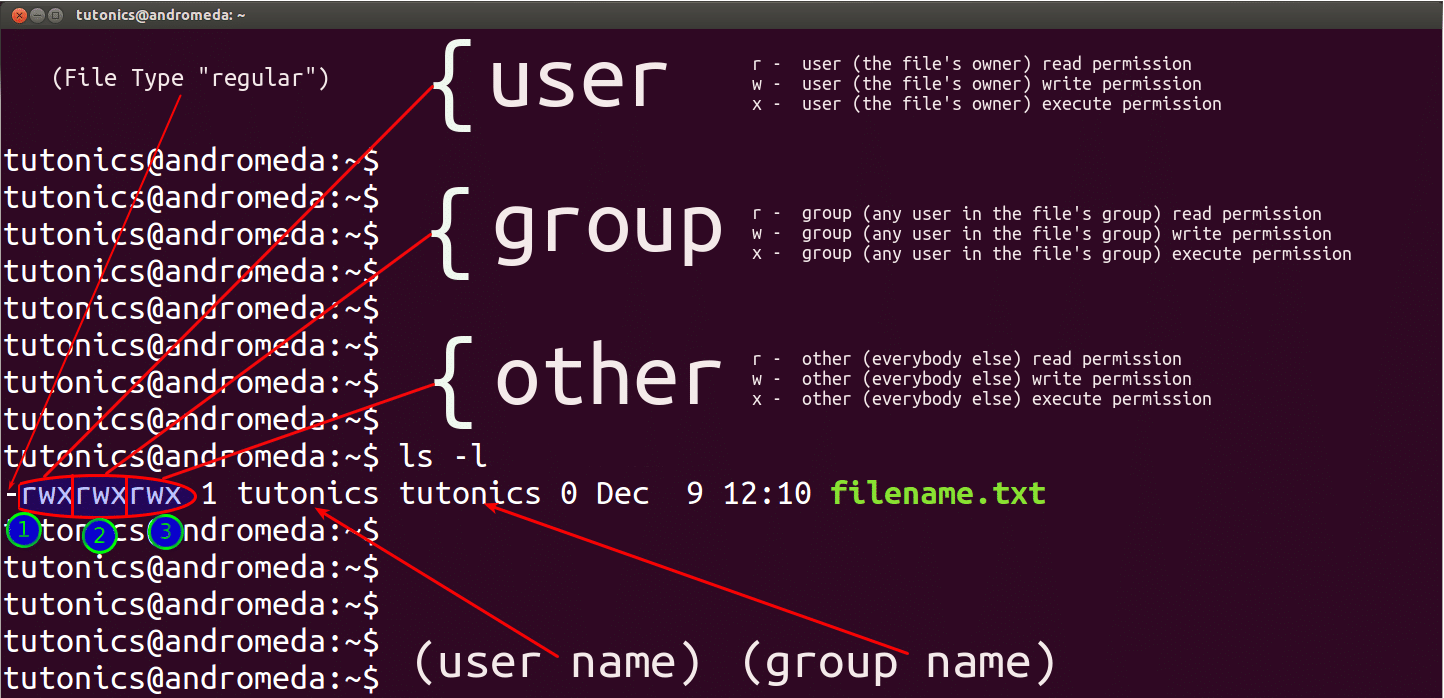


Linux File Permissions Tutorial For Beginners



2 A Alice Is The Owner An Executable Bash Script Chegg Com



Bif703 File Permissions Ppt Download



Bash Sudo Abc Sh Command Not Found Ask Ubuntu



Basic Linux Commands Linux Cli 50 Most Used Linux Commands By Sai Kumaresh Beyondx Medium



How To Use Chmod Command In Linux Explained With Examples



Gnu Linux Command Reference Goblin Refuge



Explained How To Use Chmod Command Complete Guide Youtube
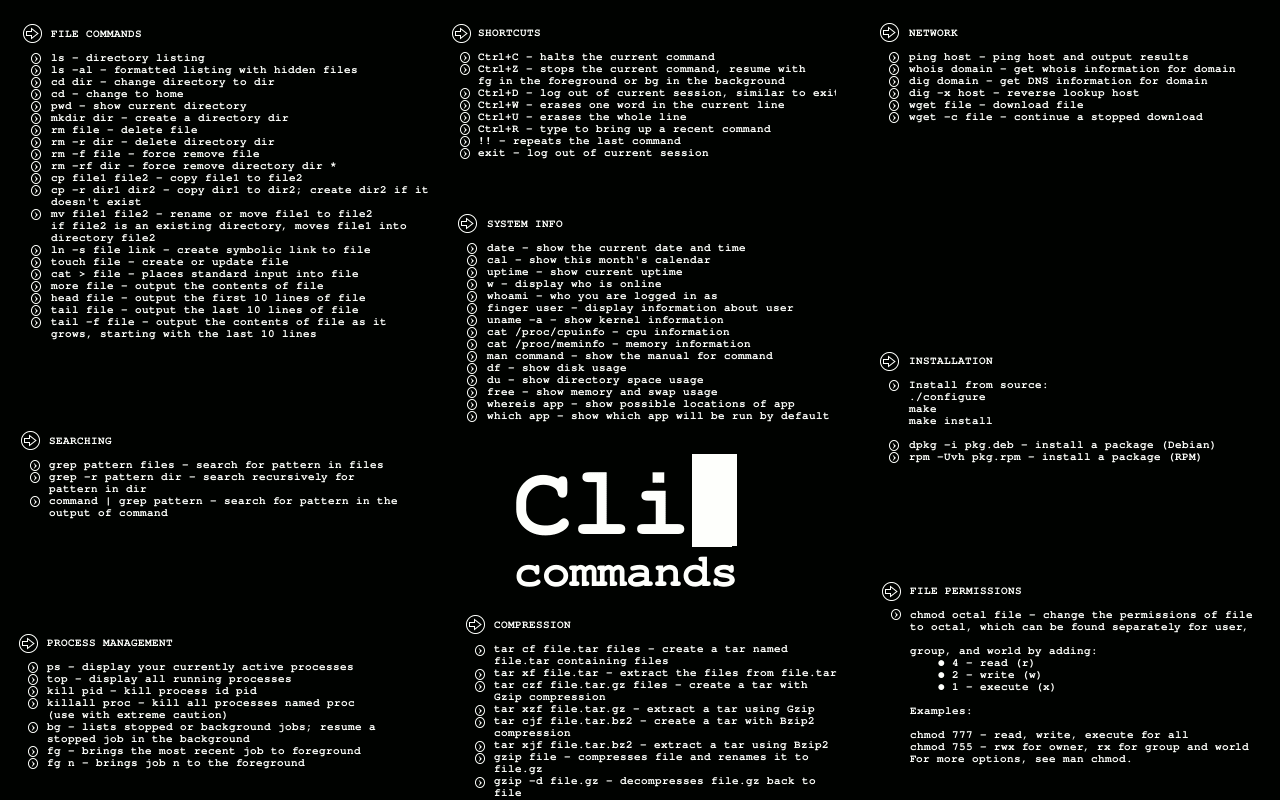


Backtrack Page Useful Commands For Kali Linux



Chmod 777 What Does It Really Mean Make Tech Easier



Unix Commands Basic To Advanced Unix Commands With Example



Linux Terminal File Permissions Chmod Chown And Chgrp Linux Line Tools Thing 1



Bash Sudo Abc Sh Command Not Found Ask Ubuntu



Basic Linux Commands



08 Unix Linux Shell File Directories Permission Chmod Command Youtube



Linux Common Commands Tutorial And Use Examples Linuxcommands Site



The Chmod Command And Linux File Permissions Explained
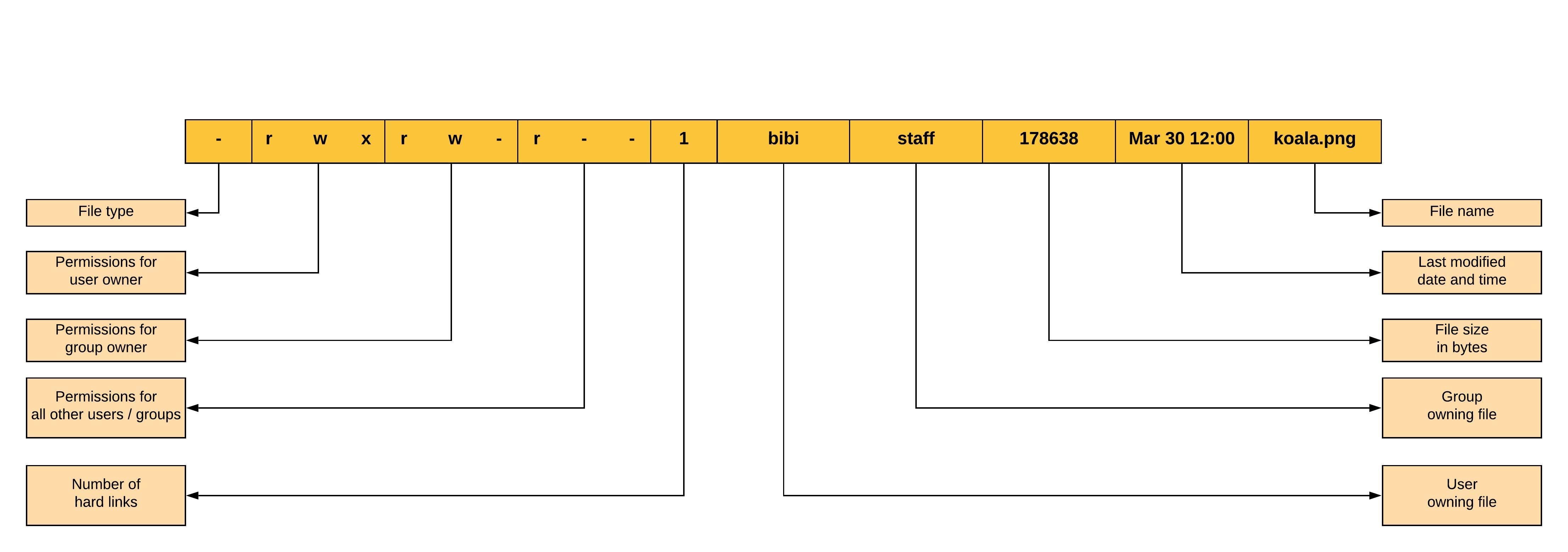


Linux File Permissions And Ownership By Udara Bibile Level Up Coding



10 Simple Linux Tips Which Save 50 Of My Time In The Command Line Dev Community



Linux Hacker Chmod 777 Command T Shirt By Clubtee Redbubble



The Unix Filesystem Commands



Directory How Can I Change Permissions Of A Folder Including Its Enclosed Files And Subdirectories Ask Ubuntu



Unix Linux Page 1 Line 17qq Com



Unix Permissions The Easy Way Index Of All Chmod Permutations By Semi Koen Towards Data Science



Linux File Permissions Complete Guide Devconnected



Some Helpful Linux Commands Recently For A Coding Challenge I Was By Kate Schlunz Medium



Permission Command How To Use Chgrp Trend Oceans



Top 50 Linux Commands You Must Know Journaldev



Linux Chmod Command Summary With Examples Youtube



A Deeper Dive Into Linux Permissions Network World



Linux Commands Linuxconfig Org



Chmod Command Linux Page 1 Line 17qq Com



Added By Galpeartech Instagram Post Update And Refresh Your Linux Knowledge Follow Galpeartech Chmod Is One Of The Most Important Command Which You Can Use To Change The Permission In Linux System



Linux Hacker Chmod 777 Command Ipad Case Skin By Clubtee Redbubble



0 件のコメント:
コメントを投稿